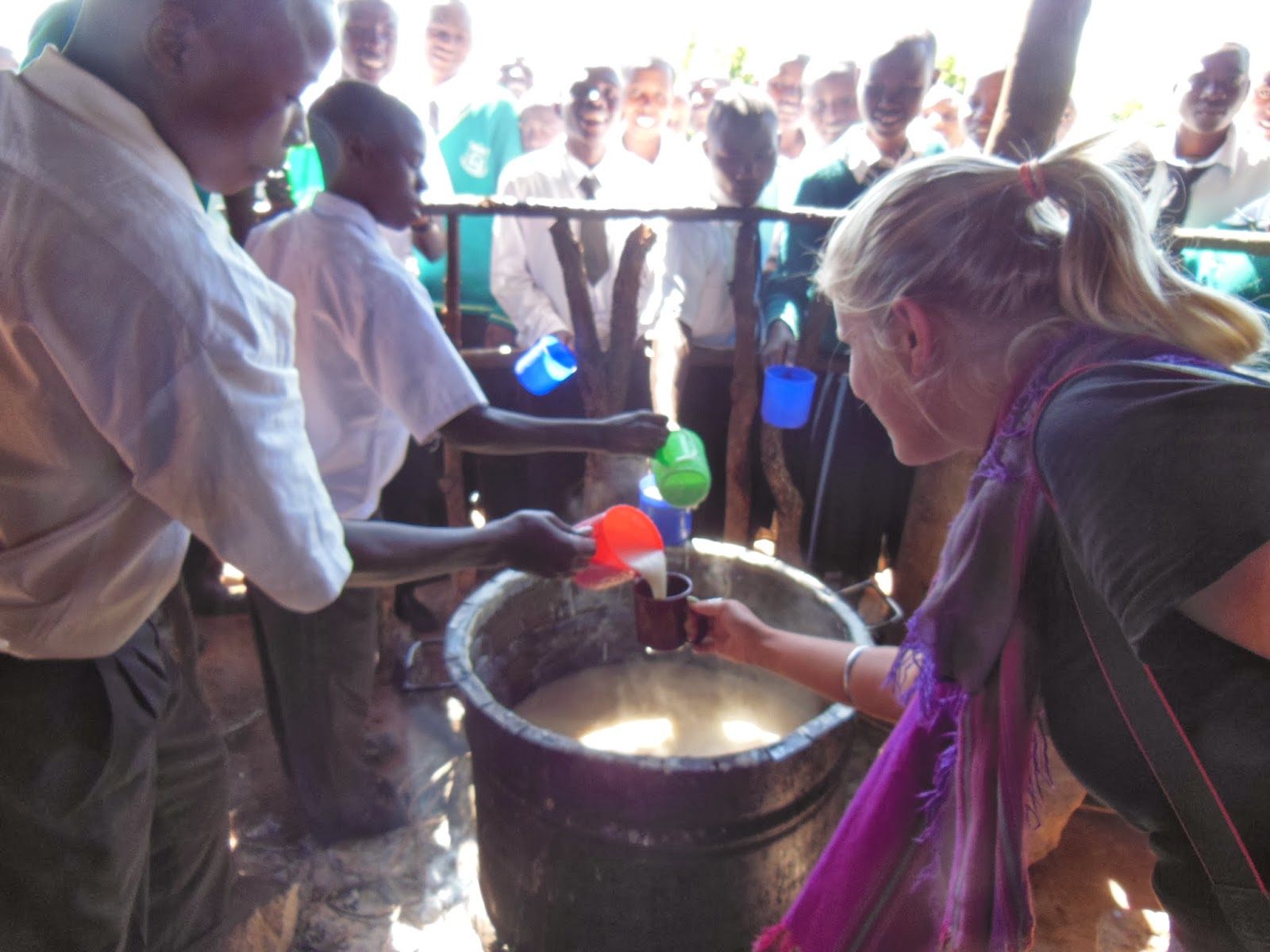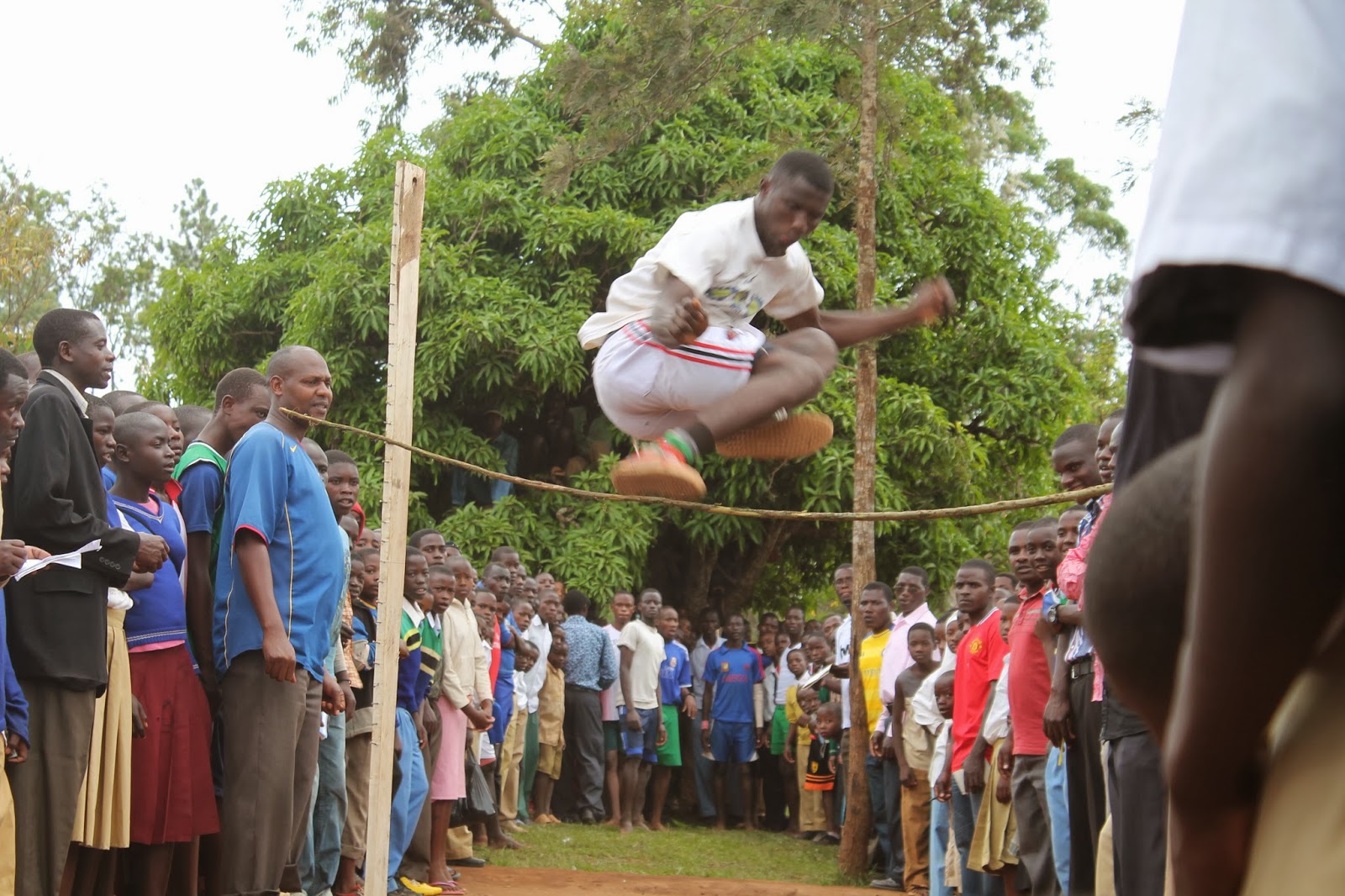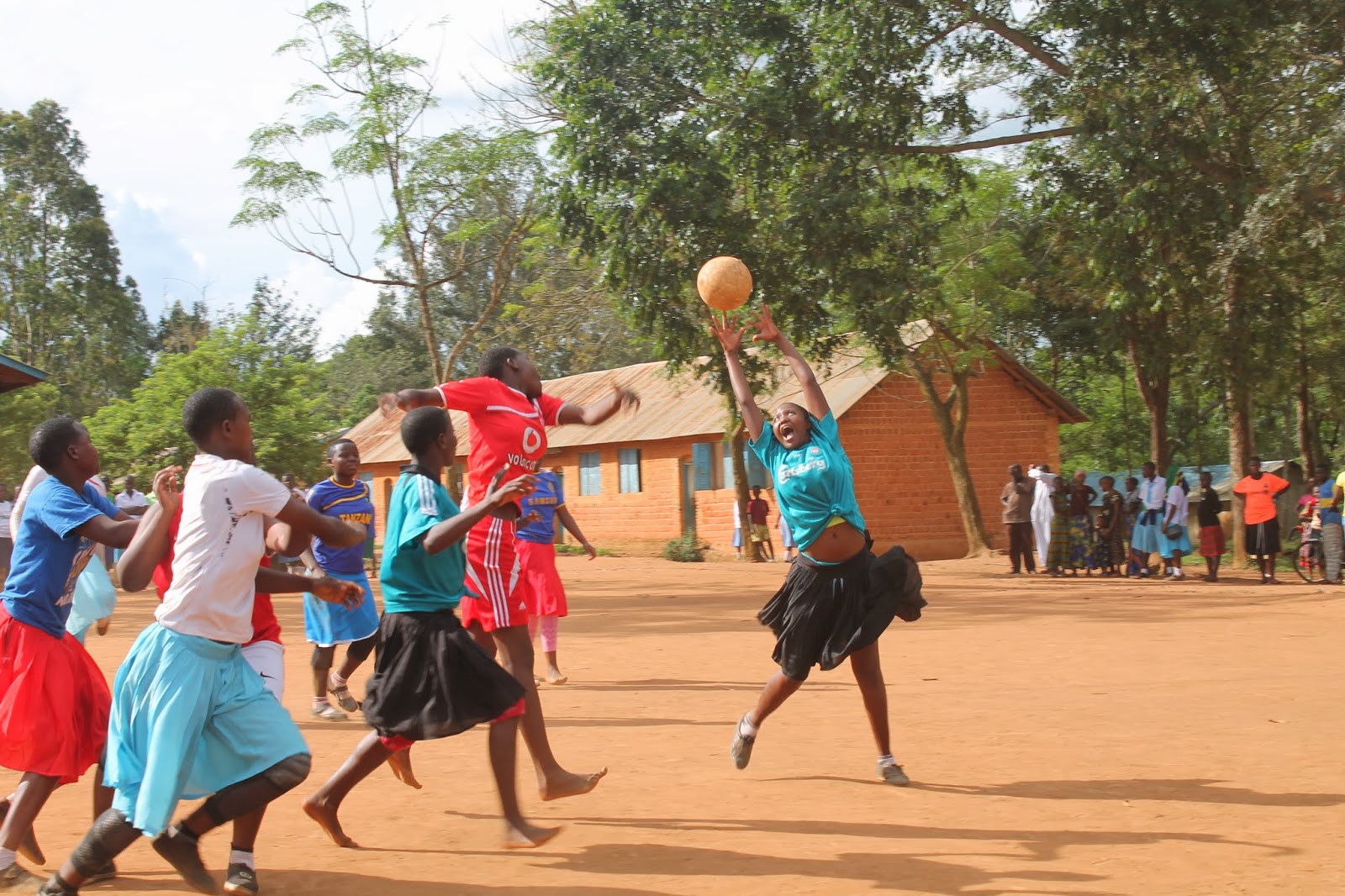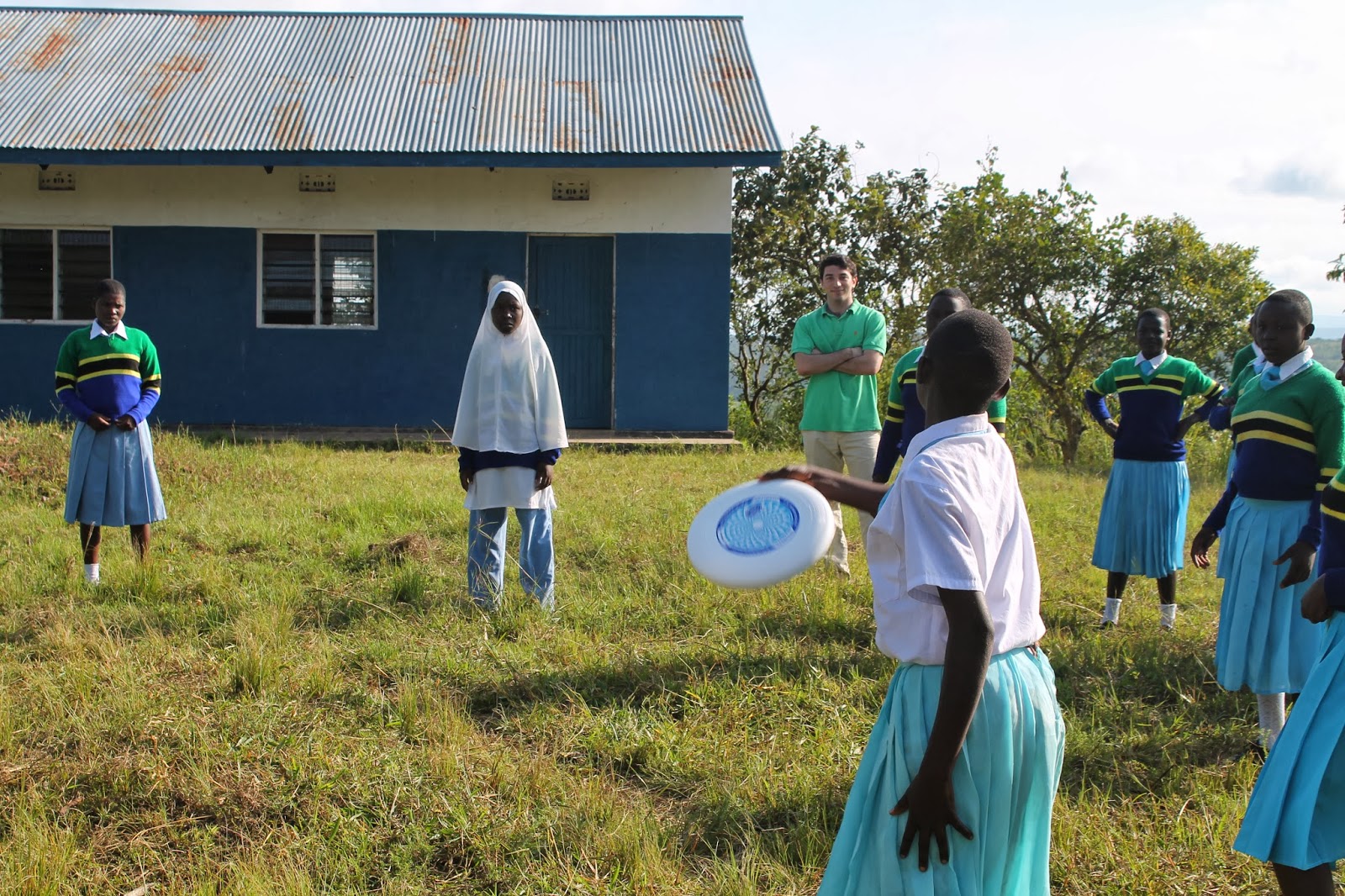Habari?
I wanted to share this list of great questions I got from students at Genesee Elementary, as well as all of their answers! Asante for sending them in!
Feel free to send in any more that you think of!
Baadaye,
Marisa
-----------
From Mrs. Gilmore's 4th grade class:
1. What is a typical school day like...(when do kids arrive, do they eat in a cafeteria, what time do they leave, do they change classes)? Do they go all year round or like us - September to June?
Great question! Before 'school' starts, all of the students arrive and "clean their portion". Each student has a small section of the school grounds or a classroom that they have to keep clean. If theirs is inside, they sweep it everyday. If theirs is outside, they will cut the grass with a machete (see the picture).
 |
| Can you imagine cutting entire fields without a lawnmower? |
Then is assembly at around 7:45AM, where students sing, listen to announcements, and take attendance before going to their classroom. In Tanzania, students stay in one classroom all day, and all of their teachers come to them!
At 8AM, classes begin and continue until 10:40. Then we had our "chai", which means 'tea'. This break lasted 30 minutes. Teachers go to our staff room and drink tea and eat buns together, and the students go and drink porridge together (see picture).
 |
| Some of my boy students drinking porridge |
After Chai, classes continue for another hour and a half or so, and from 12:30-12:40 there is a ten minute recess. After the short break, there is another class before students have their afternoon activity. Twice a week, students did work around the school or in the school's farmland to make improvements. They might cut down trees, burn garbage, cut grass, put down fertilizer, fix pathways or collect firewood (see pictures).
 |
| Sweeping the roof!! |
 |
| Cutting down branches from this tree. |
Once a week, students met for Debate, and on Friday afternoons we would have Sports and Games, where the boys played a giant soccer match and the girls played netball, which is a game that is a mix of basketball and volleyball. School ended everyday at 3PM, and a final closing assembly (see below).
One thing that is different is that the school year in Tanzania begins in January and ends in December, rather than from September-June. However, they have a long December break like we do (though I guess that would be considered summer break) and another break from May/June-August.
2. Do the kids take a bus to school? How long does it take them to get to school?
Students didn't have a bus to take to school....most families didn't even own a bicycle! So, all of the kids at my school walked to school every day. For most of them, the walk was 5 miles to school, and 5 miles home, which took them up to two hours each way. Can you imagine doing that five times a week?
3. If you are living here in NY, who is teaching the students in Tanzania?
Now that I am back in New York, the students have another English teacher. Because they were in Secondary School, they had up to ten different teachers, one for each subject. So even if they don't have a new English teacher, they still have plenty of other teachers for their studies!
 |
| Here is a picture of me and the rest of my teaching staff at Muyenzi! Except the man on the far right with the club, he was our security guard. |
-----
From Mrs. Gardiner's 3rd Grade class:
1. Do people sleep on beds or on the ground?
People do both! Some sleep on mats or a mattress right on the ground, and others have beds that keep the mattresses off of the ground. I know a lot of my students had never slept with a pillow, but people do have pillows as well.
 |
| Here is a picture of my bedroom. My bed was quite simple, but many of my students don't sleep on a mattress. |
2. Why are people poor if gold and diamonds are some of the natural resources?
That's a great question. Even though Tanzania has some amazing natural resources like gemstones, they didn't have enough money to build the proper mining equipment or factories or know who to sell them to. So, many times they allow people and companies from other companies to come in and pay for everything, which means that those outside people and companies also get most of the money. While the government gets some of the money through taxes, a lot of the profit is unfortunately lost.
Tanzania recently found a large deposit of petroleum off of the coast, and citizens are demanding that this time, the government find a deal that will give them a higher profit. Hopefully in the future, Tanzanians will have enough money to build their own equipment and factories instead of having to depend on foreigners!
3. How do people celebrate weddings?
Weddings are similar to many weddings in the United States, they have a marriage ceremony in a church or mosque, followed by a reception. The reception might be at a big party hall, or it might be somewhere in the village; depending where you live. For big celebrations, it is very common to hire a DJ to come and play music, as well as to have an EmCee! Tanzanians love to dance!!! They also will eat a lot of common Tanzanian food, including cooked beef, goat, chicken, boiled bananas, rice, and salad. For drinks, the families will provide crates of sodas (Coca Cola, Sprite, Mt. Dew, Pepsi) and beer for the adults.
However, unless you have a lot of money, women might not have a white dress to wear for the wedding and will wear a fancy dress made of local fabric instead. People also do not buy a lot of flowers and decorations in the same way we do here in the United States.
One thing that is unique for weddings in Tanzania is that when you are invited, you send your gift (of money) before the wedding begins. If you are not going, you can give a little bit, but if you are attending, you are expected to give more. That is because the money collected is used to pay for the wedding -- particularly the food and drinks!
4. What national holidays do you celebrate?
Alongside celebrating popular Christian and Muslim holidays, Tanzania also has some unique national holidays. I've included most of them below:
-- Zanzibar Revolution Anniversary
January 12th, celebrates the overthrow of the Sultanate in Zanzibar in 1964
-- Union Day
April 26th, celebrates the unification of Zanzibar and Tanganyika into the Republic of Tanzania in 1964. This day is like our 4th of July!
-- Saba Saba Day (which means 7,7 day)
July 7, celebrates the founding of the first political party in Tanganyika. It is also the day in which the International Trade Fair is held every year.
-- Nane Nane Day (which means 8,8 day)
August 8th, is also known as Farmer's Day, celebrates the farmers' contribution to making Tanzania a great country.
-- Nyerere Day
October 14, celebrates the first president of Tanzania, Mwalimu Julius Nyerere. They LOVE Nyerere, just like how we love and celebrate George Washington each year!
-- Independence Day
December 9th, celebrates Tanganyika's independence from the British in 1961.
5. What do you use for money?
The Tanzanian currency is called the Shilling. There are 1,500 shillings for every $1 USD. Just like in the US, they have coins and paper bills, but the numbers are all different! However, the largest bill is only 10,000 -- which means if you're rich, you need to buy a big wallet!
-----
From Mr. Musso's 3rd grade class:
1. Are all the houses like the one in your picture, made of mud and wood?
No, but a lot of them are. Others are made of wood and have corrugated iron sheet metal roofs, walls, or doors, and others are made from cement, like mine was. Here's a picture of my house so you can compare!
-----
From 5th graders:
Lauren wants to know if Tanzania has a pledge of allegiance like we do.
As far as I know, Tanzania does not have a pledge of allegiance. However, students do sing one of two songs at the beginning of the day, either the national anthem or the unofficial song of Tanzania.
Madison wonders if there are hospitals in Tanzania.
There are definitely hospitals in Tanzania; I know because I had to stay in one once when I got very sick! However, most of them are not like what we think of when we think of hospitals because there are a lot of differences. Hospitals are also not as common and do not have as many nurses and doctors as they do in America, so many times people go to a dispensary, where you can meet with a nurse and get medication for illnesses, instead of going to the hospital.
Here's a picture of the dispensary near my house where I went once when I had a bad cough.
 |
| The dispensary is the building on the left. |
Unfortunately, I don't have any pictures of the hospital I went to, but they didn't even give patients drinking water! You had to bring your own pillow, water, clothes, food, towels, etc. The only thing they provided was a room (with no call button!) with a bed and a small sofa and chair and my medications.
Alyssa wants to know at what age children start school.
Students start going to school for first grade, so about when they are 5-7 years old. However, some students start later, or take off time between grades because their parents don't have enough money to pay for school every year. Even in first grade, all of the students wear uniforms!


















































